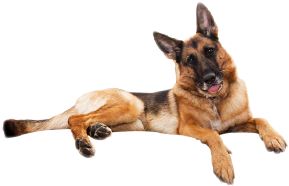The opposites make the most beautiful harmony and all comes through conflict
Heraclitus
Introduction
In various discussions about IPO, especially when the question of the difficulty of this sport is raised, the thing put first is versatility. It is very difficult to find a dog, it is argued, that can be good in tracking, obedience and protection work at the same time, and preparing such a dog to a decent level in all three disciplines requires a great amount of work and skills from the handler. Moreover, this versatility is exposed as the essence of IPO in another name of this sport: VPG, which stands for Vielseitigkeitsprufung fur Gebrauchshund, so literally: Utility Dog Versatility Test. To me, however, the uttermost difficulty and at the same time the essence of IPO is not versatility, but something much more fundamental, that permeates all three parts, underlies them and makes harmonious work in all of them possible. To me the essence of IPO is conflict.
Definitions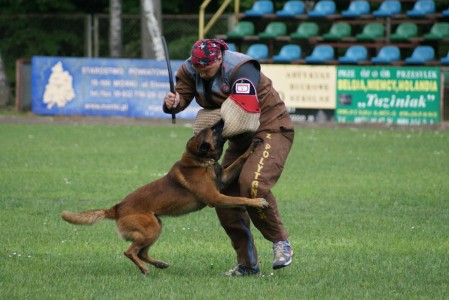
Let us begin with defining basic notions. By conflict I mean simultaneous occurrence or immediate consecutiveness of opposite requirements/mental states. Next, drive is understood here (unless stated otherwise) as passion, willingness and energy which a dog puts into his actions. This understanding is, of course, quite remote from a technical meaning of the term used in psychology or ethology and much closer to the one common to IPO jargon. Such understanding will help to avoid controversy over the drives (in ethological sense) in which the dog is supposed to work – or actually works – in each exercise, as well as over what exactly does and what does not count as drive; needless to say, however, that the passion of a dog is often a result – mainly or solely – of the drive or drives he is working in at a given moment. Finally, by control I mean readiness to immediately disengage from the action being taken and to switch into different emotional state.
Drive, control and harmony
Whole IPO, on the part of requirements, comes down to a fundamental conflict between drive and control. The dog is expected to be fully involved in every activity and emotional state, and despite that, to be able to immediately switch to another behavior and different emotions. These two elements must remain in perfect balance: drive cannot disturb control; on the other hand, control cannot suppress drive. A good IPO performance is a concert resounding with the harmony of these two opposite notes. In this harmony both tones sound to their fullest, yet they do not interfere with one another.
It is easy to train a dog who is only motivated or only under control. Using Ashley Foster’s comparison, it is fairly easy to reach a high speed on a straight track, as in a dragster race: it is enough to have a good vehicle. It is also easy to do something very precise without any haste, like threading a needle. The real challenge begins, when both highest speed and greatest precision are required. An example is Formula 1 racing, where success depends both on highest driver skills and the top quality of a vehicle, which has to endure extreme g-forces resulting from rapid accelerating and decelerating. Such accelerating and decelerating – rapid and alternate – is exactly what the dog must face in the IPO routine.
In this perspective let us now have a look at each of the IPO phases.
Protection Work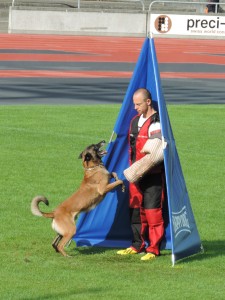
The conflict of opposites and harmony within this conflict is most clearly seen in the protection work, where the dog must almost constantly confront the pressure resulting from it. It all starts already in the first exercise, that is in searching for the helper. Most often, the dog knows where the helper is (paradoxically, this is one of the biggest difficulties of this exercise for those who do not train IPO), and yet he has to go around five other blinds. He has to do it fast, but tightly and attentively, while at all times paying attention to the handler in the middle of the pitch. It is easy to keep full pace, if a dog goes around almost two blinds at once or immediately runs to the helper. It is also easy to circle the tents tightly, if a dog only trots. The precision is also easy to achieve when a dog treats searching the blinds strictly as an obedience exercise, not even noticing the helper in the last tent (it is rare, but happens). But only a combination of speed, precision and full energy put into circling each and every blind, with readiness to engage the helper make this exercise excellent.
Even more immediate conflict occurs during hold and bark, when the desired goal is so close, and yet the dog cannot catch or even touch it. To praise a dog who bites or jumps on a helper for being so tough and dominant is like praising a Formula 1 driver who is so fast, that he falls out of the track. Such dogs always lack control. Next, the dog must be engaged to his fullest in holding and barking, without getting distracted by approaching handler, and yet, on his command, immediately stop barking and come to basic position as fast as possible. During the last year FMBB, when the crowd was applauding a famous handler’s dog after very fast recall from the blind, two Czechs standing beside me near the tent looked at one another and asked: “Where’s the drive?”. That is the point. Fast recall is easy when the dog lacks full involvement in barking. Strong barking is easy when the dog lacks obedience afterwards. But only a combination of these two elements can bring a high mark in this exercise.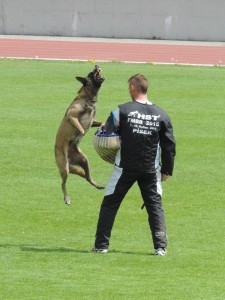
A very vivid example of coexisting extremes is back transport and attack out of it. Sticking to the handler’s leg, but looking attentively at the helper; looking attentively at the helper, but restraining from fight; restraining from fight, but being ready to immediately release all the energy and put it into grip as soon as the helper attacks. A transport with an eye contact to the handler? Pretty easy; not until recently such execution of this exercise had what it takes to get an ‘Excellent’. A transport with focus to the helper but without obedience to the handler? Even easier. An obedient transport with eye contact to the helper, but without intensity, all this followed by a spiritless attack? Still easy. Only a combination of precision beside the handler and focusing all the energy on the helper, while at the same time controlling this energy until the attack, to release it with a full power – that is to be seen only in a very good handler and a very good dog.
A special word must be said about fighting on the sleeve. Here the dog has to present a full and even grip as well as commitment both when the helper is active, moves and hence agitates the dog (pressure phase), and when the helper is passive and the sleeve does not move (transition phase). In spite of this commitment the dog has to release the grip as soon as the command is given, but at the same time cannot anticipate or act prior to the command, which can often be seen in dogs who loosen the grip in the transition phase and – more or less visibly – chew the sleeve. The best dog is like a seasoned Formula 1 driver: on a straight he speeds up to the fullest and although he knows that he is approaching a tight corner, he does not release the accelerator, only to instantly brake in the very last moment and enter the corner, ready to immediately speed up again, facing unimaginable g-forces. Split second too early and the rival will be faster. Split second too late and the vehicle will crash.
Obedience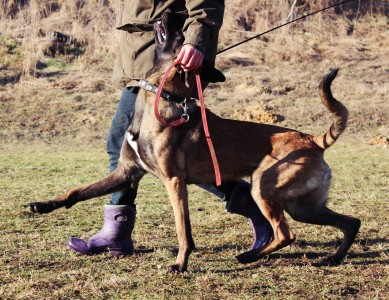
The conflict and harmony of opposites can also be seen in obedience. Already in the heelwork there is a sharp contrast between long legs and turns, as opposed to the sport of obedience, where the legs are short and turns frequent. Long legs prompt a dog to pass ahead of the handler; moreover, they are monotonous which make it more difficult for a dog to keep full focus all the time, and yet the dog must remain concentrated and motivated. The turns after long legs can be surprising (no command allowed), but the dog must be ready for them; on the other hand, he cannot anticipate them or turn too early. The same goes for ‘sit’, ‘down’ and ‘stay’ out of motion. To take each position fast, the dog usually knows exactly what he is about to do, and despite that he cannot do it prematurely, which is often seen on trials. The dog has to stay focused and precise throughout whole heelwork. In addition to this, after “down” and “stay” the dog awaits recall, and yet he must lay or stay still and stable; on the other hand, this stillness cannot suppress eagerness to recall, and as soon as the command is given, the dog must instantly react and run back to his handler as fast as possible; being this fast, he has to stop right in front of the handler without bumping into, or even touching them. A similar game of accelerating and decelerating can also be seen in the send out exercise. The dog must dash forward, fully focused on the goal ahead of him, but as soon as the command is given, even though the goal is close, he must abandon it and lay down. Laying down cannot decrease pace; full pace cannot spoil laying down. Here again, before sending out the dog must perform 10-15 paces of heelwork. Although he knows, he is about to be sent out, he must do it precisely, best case scenario – in the very same way as in the rest of the routine.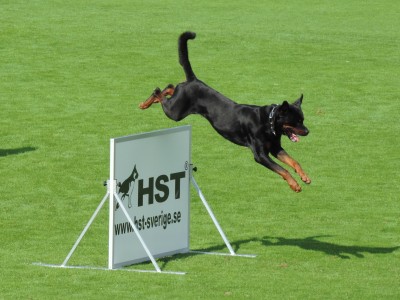
Also in the retrieves the game of opposites marks its presence strongly. Still and calm sit in the basic position while the dumbbell is thrown (now very closely examined by the judges) cannot result from the lack of drive or weaken it; the drive and willingness to fetch the dumbbell as fast as possible cannot disturb the ‘sit’ in basic position. Full control; command; split second; full burst of energy. Close attention must be also paid to the last phase of the retrieve exercise, that is front position with the dumbbell in the mouth and giving it to the handler. Even in the highest rank trials we can often see handlers who hastily reach for the dumbbell and give the dog command to let it go. Best teams are far from any kind of haste. The dog holds the dumbbell fast all the time, even when his handler’s hands reach out to it, and yet, as soon as the command is given, he lets go of the dumbbell. What is the difficulty in releasing something that one does not want to hold? What is the difficulty in holding something that one does not want to release? But the conjunction of opposites, that is strong hold and fast release, and all that in trial conditions, is what only the best are capable of.
Tracking
The necessity of harmonizing drive and control can also be seen in tracking, although perhaps not as clearly as in the other two phases. In this part it results from requirement of the highest precision which cannot suppress the passion to work. 600 paces are not quite a long distance and covering it with freestyle tracking is not a big challenge even for a dog with a mediocre willingness to search. But working the same track with a deep nose, although the nature, weather conditions and various distractive scents discourage from doing so, requires big passion as well as control, and neither of these can disturb the other. A dog that only has passion will lack precision, stray from the track, miss the articles or mark them askew, miss the corners or track with his nose high; a dog that only has control will perhaps be precise, but his work will lack intensity and commitment; any problem will probably end his work, because such a dog will lack motivation to find the track. So the IPO nosework must be intense but not hasty, full of passion but precise, independent but compliant with the rules imposed by training.
Conclusions
In this description we can see that the conflict in IPO comes to play to different extent in each phase. It stands out most clearly in protection, less so in obedience and the least clearly in tracking. Let us notice that it corresponds strictly to the level of difficulty of each phase. The most complex and difficult is the protection work. Here most drives (in ethological sense) come into play, resulting in the highest number of behavioral and emotional components that may come into conflict with one another and hence need harmonizing. To this handler VS helper conflict must be added. In the obedience the latter is of course absent, and moreover there are less drives (again, in ethological sense), mental qualities and emotional states that come into play (eg. no aggression, willingness to fight or dominance). And finally, there goes tracking where the conflict is of least importance and where it is easiest to get a high score – if anybody scores 100 points in the world championships, we may be sure that it is a result of phase A.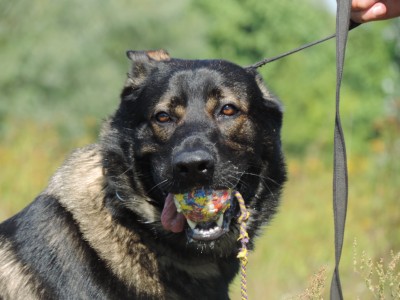
From what has been said above also emerges a picture of the perfect dog for IPO. It is namely a dog with the widest drive range (in ethological sense), tough, brave and dominant towards a human, due to which it is possible to achieve the fullest possible harmony and expression in his work; at the same time – speaking of his temperament – it is a dog that is balanced, i.e. sanguine, thanks to which the above mentioned drive and mental quality range does not fall apart into dappled chaos. Sanguinity is a temperament type in which arousing and inhibition processes remain in balance: both run equally fast and intensively, and this is exactly – as I argued above – the main requirement of IPO. I stress it here, with all my awareness, against numerous choleric type fans, according to whom a good IPO dog must be hyper-excited, cocaine-powered nut. Speed, dynamics, passion and commitment to work will be the same in both types (arousing) but gaining control in training and maintaining it over trials (inhibition) will be much more difficult in the choleric type, simply because it is more remote from his nature.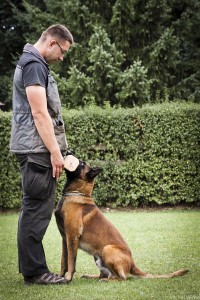
Another key quality of an IPO dog is the pack drive. Here I am not willing to go into controversy of any kind over this term, whether definitional (whether or not such “drive” meets requirements of one or the other definition of drive) or terminological (pack drive VS social drive VS sociability etc.). However, I prefer to use the word “drive”, because I want to point out that it is an inborn quality. By pack drive I mean an urge to please the handler. From this results the willingness to do something for them and not (or not mainly) for an external reward, which we can call cooperativeness. Off course, such cooperativeness is also a result of good bond between a dog and his handler, but such bond is possible only with a dog with properly expressed pack drive. How does cooperativeness help the dog and the handler work in IPO? Sticking to automotive analogies, we may say that it works similarly to the clutch, coupling opposite behaviors and emotional states. Let us have a look at this in protection, where it can be seen in almost every exercise. Recall from hold and bark or releasing the sleeve requires from a dog temporally stopping and restraining from activity of the uttermost pleasure. It is much easier to achieve when the dog can be rewarded not only with a permission to engage in this activity again, but when the reward is for him intrinsic to the very act of recall or releasing the sleeve. In other words, for a dog with pack drive and good bond with his handler it is much more natural to temporarily restrain from realizing other drives, because he does so for his handler, which in itself is pleasant for him. And the easier and more natural something is for a dog, the lower is the expense with which a handler can achieve it. In practice it most often comes down to a lesser degree of compulsion required in teaching particular elements, which in turn has a positive influence on adjacent exercises. For example, the less compulsion used in teaching recall from hold and bark, the lesser the risk, that a dog gets anxious on his handler approaching, starts looking around, weakens the barking or recalls prior to the command; in such case there is also less risk of negative emotions on the part of the dog in the basic position after the recall, and then in heeling to the escape line etc. The less compulsion used in teaching to release the sleeve, the lesser the risk that the dog gets anxious about the anticipated command and weakens the grip, starts chewing on the sleeve, releases prior to the command, or on the contrary – “jams” on the sleeve, not willing to release it at any cost. I can often hear, especially among GSD people, words of admiration about dogs that have notorious problems with releasing. They find them so tough, so brave, so aggressive, so dominant. In these words we can hear laudation of the real dog as opposed to a merely sport dog (without problems with releasing) that lacks bravery, as well as longing to good old times when IPO dogs would work in Raiserian grey, before increasing demands of this sport turned it into a green and blue circus. To me it is one of the most common excuse of one’s poor results in IPO, based on a false assumption that pack drive cannot coexist with bravery, dominance and aggression (or, if preferred, blue with grey). I have seen many good dogs with exceptional pack drive and plenty of willingness to cooperate with the handler, and at the same time extremely tough and dominant while fighting against helper. On the other hand, all dogs with problems with releasing, that I could observe on trials, training and in everyday situations with their handlers, had weak pack drive and/or poor relationship with their handler and/or bad training. Of course, weak pack drive can have negative influence on other aspects, namely relationship and training, but all the more so I cannot see any reason to present such dogs as the ideal. Again, it is like praising a Formula 1 driver who keeps disobeying his team’s bosses, dashes like crazy and crashes his car on every race.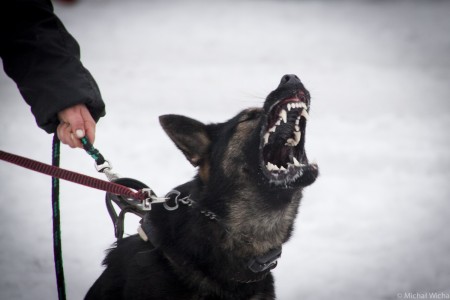
Why do I pay so much attention to this? Because against many dog people, majority of whom come from the circle of not-willing-to-release-badass fans, I state that the sport of IPO, which essence is conflict, is a good test of real utility of dogs, and not merely a circus tricks contest that long ago detached from the real life in pursuit of points. It is exactly the necessity to face and withstand omnipresent conflicts that requires such mental qualities that will be useful also in real work. To me a strong dog is not a dog that unbreakably clenches his mouth on the sleeve and keeps arousing like crazy. To me a good dog is one that is capable of continuously switching between extreme mental states without damage to his psyche, fully engaging and feeling good in each and every of them and thus achieving internal balance that enables him to successfully compete for several seasons. Pierre Walstroem, when asked about the differences between a sport and service dog, said: “The statement <<sport dog>> or <<real dog>> is inaccurate and completely wrong! A good German shepherd is a dog for any breeding program”.
And lastly one remark on the alleged unnaturalness of IPO. IPO, as described above, demands from a dog full involvement in every activity and mental state, and then immediate and full switching this involvement into another activity and state. In a good and well prepared dog there is no lingering in what was happening before nor anticipating what is going to happen next. There is only full devotion to the now. Now if we agree that one of the aspects of dog’s nature that distinguishes him from us is “living in the moment”, perhaps the dogs that train IPO may at the same time be more… dogs. If so, could there be any sport closer to his nature?
Patryk Krajewski


